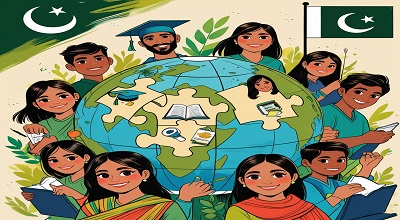Education Reform Initiatives in Pakistan
Education Reform Initiatives in Pakistan: Education is a fundamental pillar for national development, yet Pakistan has faced significant challenges in providing quality education to all its citizens. Over the years, successive governments have introduced various education reform initiatives to address issues such as low literacy rates, gender disparities, outdated curricula, and insufficient infrastructure.
This article explores the latest education reform initiatives in Pakistan, providing examples of policies, programs, and their impacts. From the Single National Curriculum (SNC) to digital learning advancements and girls’ education programs, we analyze how these reforms aim to transform Pakistan’s education landscape.
Historical Context of Education in Pakistan
Pakistan’s education system has evolved through multiple phases since independence in 1947. Initially, the system was influenced by British colonial structures, with Urdu and English as primary mediums of instruction. However, disparities between urban and rural education, along with a lack of standardized curricula, led to fragmented learning outcomes.
Key historical milestones include:
- 1972 National Education Policy: Focused on universal primary education.
- 1998-2010 Education Reforms: Introduction of public-private partnerships.
- 2009 Right to Education Act: Ensured free and compulsory education for children aged 5-16.
Despite these efforts, Pakistan continues to struggle with low literacy rates (around 60%) and high dropout rates, particularly among girls.
Key Challenges in Pakistan’s Education System
Several systemic issues hinder progress in Pakistan’s education sector:
- Low Enrollment & High Dropout Rates: Nearly 22.8 million children are out of school.
- Gender Disparity: Only 47% of women are literate compared to 71% of men.
- Outdated Curriculum: Lack of modern skills like critical thinking and digital literacy.
- Teacher Shortages & Quality: Poor teacher training and absenteeism.
- Funding Issues: Education receives less than 2% of GDP, far below UNESCO’s recommended 4-6%.
Recent Education Reform Initiatives in Pakistan
Single National Curriculum (SNC)
Objective: Standardize education across public and private schools to reduce disparities.
Implementation:
- Introduced in 2021 for grades 1-5, later expanded.
- Focus on Islamic teachings, national unity, and STEM subjects.
- Example: Punjab’s SNC rollout included teacher training and updated textbooks.
Challenges: Criticism over religious content and implementation delays.
Digital Learning and STEM Education
Initiatives:
- DigiSkills.pk: Free online courses in freelancing, digital marketing, and coding.
- STEM Pakistan: Promoting science and technology education in schools.
- TeleSchool & Teleschool App: Launched during COVID-19 to provide remote learning.
Impact: Increased access to digital education, especially in rural areas.
Girls’ Education and Gender Equality Programs
Key Programs:
- Benazir Income Support Programme (BISP): Conditional cash transfers for girls’ education.
- Girls’ Stipend Programme (Punjab): Financial incentives for female students.
- Malala Fund Initiatives: Advocacy for girls’ education in Khyber Pakhtunkhwa (KP).
Success: Increased female enrollment in KP and Punjab.
Teacher Training and Professional Development
Reforms:
- PITE (Provincial Institutes of Teacher Education): Training programs for educators.
- National Professional Standards for Teachers (NPST): Framework for teacher competency.
- AIOU’s Distance Learning Programs: Upgrading teacher qualifications.
Impact: Improved teaching methodologies but uneven implementation.
Public-Private Partnerships (PPPs) in Education
Examples:
- PEF (Punjab Education Foundation): Subsidizes low-cost private schools.
- Adopt-a-School Program: Private sector support for government schools.
Outcome: Improved infrastructure but concerns over privatization.
Higher Education Reforms (HEC Initiatives)
Key Efforts:
- HEC’s Quality Assurance Programs: Accreditation of universities.
- Scholarship Programs (e.g., Ph.D. scholarships abroad).
- Online Education (e.g., Virtual University of Pakistan).
Challenges: Limited research funding and brain drain.
Non-Formal and Vocational Education
Initiatives:
- National Vocational & Technical Training Commission (NAVTTC): Skills development programs.
- Tameer-e-Pakistan Schools: Non-formal education for out-of-school children.
Impact: Increased employability but limited scale.
Impact of Education Reforms
- Increased Enrollment: Due to stipends and awareness campaigns.
- Improved Digital Access: TeleSchool and DigiSkills expanded reach.
- Gender Parity Progress: More girls in schools due to BISP and stipends.
Limitations:
- Uneven implementation across provinces.
- Funding shortages and bureaucratic delays.
Criticisms and Challenges in Implementation
- SNC Controversy: Perceived ideological bias.
- Teacher Resistance: Lack of motivation for new training.
- Corruption & Mismanagement: Funds diverted in some regions.
Future Prospects and Recommendations
- Increase Education Budget (to at least 4% of GDP).
- Enhance Monitoring & Accountability.
- Expand Digital Infrastructure.
- Strengthen Provincial Coordination.
Conclusion
Pakistan’s education reforms show promise but require sustained political will, funding, and public support. Initiatives like the SNC, digital learning, and girls’ education programs are steps in the right direction, yet challenges remain in execution and scalability.
FAQs
Q1: What is the Single National Curriculum (SNC)?
A: The SNC is a standardized curriculum for all schools (public and private) to ensure uniformity in education.
Q2: How has digital learning improved education in Pakistan?
A: Programs like TeleSchool and DigiSkills have expanded access, especially during COVID-19.
Q3: What are the main barriers to girls’ education in Pakistan?
A: Cultural norms, poverty, and lack of schools in rural areas hinder girls’ education.
Q4: How effective are teacher training programs?
A: While programs like PITE and NPST help, inconsistent implementation limits their impact.
Q5: What role does the private sector play in education reforms?
A: PPPs like PEF and Adopt-a-School improve infrastructure but raise equity concerns.
Free Here: Lucky Sudoku APK
